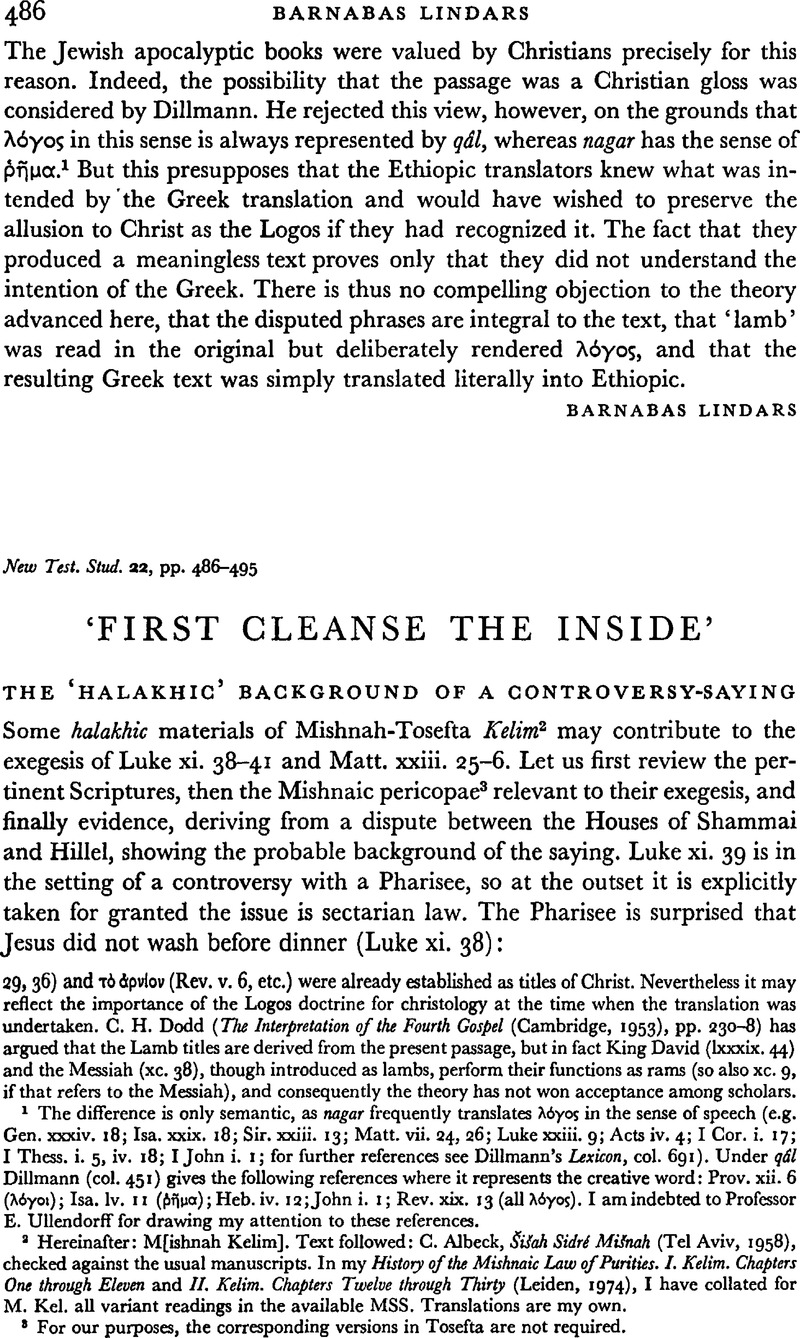Published online by Cambridge University Press: 05 February 2009

page 486 note 2 Hereinafter: M[ishnah Kelim]. Text followed: C. Albeck,. Šišah Sidré Mišnah (Tel Aviv, 1958), checked against the usual manuscripts. In my History of the Mishnaic Law of Purities. I. Kelim. Chapters One through Eleven and II. Kelim. Chapters Twelve through Thirty (Leiden, 1974), I have collated for M. Kel. all variant readings in the available MSS. Translations are my own.
page 486 note 3 For our purposes, the corresponding versions in Tosefta are not required.
page 487 note 1 In an oral tradition.
page 488 note 1 Readers familiar with the rabbinic exegetical tradition on M. 25: 1, 7–8 and M. 2: I will find the following exegesis alien. For the established exegetical tradition on M. 25: 1 A, etc. is that the condition of the inside of a utensil determines the condition of the outside. That tradition is based upon a reading of M. 2: 1 in the light of M. 25: 1, 7–8, and of the latter in the light of the former. In fact, I shall here try to show, that view of law is held only by the House of Hillel. Moreover, reading the two passages without the assumption that they form part of a unitary system of law does not yield any presupposition whatever on whether, if the inside of a utensil is unclean, the outside is unclean as well. In fact neither pericope is clear on that point or even addresses it. I have discussed the matter at some length in History, iii, 375–7Google Scholar. It would not advance the present discussion to rehearse that discussion.
page 488 note 2 Clearly, neither part is assumed to affect the status of the other as to uncleanness. This rule bears a solid attestation by Judah and Meir and is prior to their time, c. A.D. 150. All it shows is that utensils were deemed divided, and the assumption is that the division has to do with the effects of contamination.
page 490 note 1 Our problem does not require the comparison of the supplement in Batra, Tosefta Kelim Bava 3: 9–11.Google Scholar
page 491 note 1 The whole depends on Joshua's opinion ( Yadaim, M. 3: 1Google Scholar) that liquids render the utensil unclean. The sages there hold only a utensil made unclean by a Father of uncleanness makes the hands unclean. It would be difficult to show a more perfect logical and chronological progression of rules than the set going first, from Joshua, (c. 70–90Google Scholar), through ‘Aqiva (c. 80–110), to Meir + Yosé (c. 130–50).
page 491 note 2 As stated above, p. 488, n. 1, I doubt that that supposition was taken for granted before the completion of Mishnah. My guess is that it was generated by Yohanan's observation, cited below, about the Houses.
page 492 note 1 Palestinian Berakhot, Talmud 8: 2Google Scholar, cited according to the usual printed editions and checked against The Palestinian Talmud Leiden MS. Cod. Scal. 3. A Facsimile of the Original Manuscript (Jerusalem, 1970Google Scholar). The translation is my own.
page 493 note 1 I trust no one will now conclude that our attempt is to prove Jesus was a Hillelite! The net result, in fact, is to support the thesis of Vermes, G., Jesus the Jew (London, 1973: CollinsGoogle Scholar).
page 494 note 1 See my Rabbinic Traditions about the Pharisees before 70 (Leiden, 1971), 11, 1–5Google Scholar. The priority of Shammaite over Hillelite opinions in the years before 70, to the degree that their disputes interested and affected the Pharisaic party at large, is established on form-critical grounds in my work. Still more significant arguments are adduced in Finkelstein, Louis, Akiba. Scholar, Saint and Martyr (Philadelphia, 1936Google Scholar, reprint, 1962), pp. 304–6Google Scholar in behalf of the view that Gamaliel II, the patriarch who succeeded Yohanan b. Zakkai shortly after 70, was an adherent of Shammaite opinions. If so, it seems to me the pre-70 patriarch Simeon b. Gamaliel is apt to have handed on such opinions to his son. But the best evidence of the state of affairs seems to me to derive from the saying under discussion, which I think it is clear takes for granted that the Pharisaic law was as defined by the House of Shammai.
page 494 note 2 I tend to think that the stress on maintaining Temple purity in the eating of meals outside of the Temple, and the larger conception that the ordinary folk should behave as if they were priests, indeed was an innovation, coming probably at the turn of the first century A.D. See my Idea of Purity in Ancient Judaism. The Haskell Lectures for 1972–1973 (Leiden, 1973Google Scholar) and From Politics to Piety: The Emergence of Pharisaic Judaism (Englewood Cliffs, 1972Google Scholar). If so, then the controversy-sayings before us as a group should testify to sharp debates on issues current in the first century, down to 70. The stress of the Pharisaic group addressed by the sayings was on creating in everyday life the conditions of purity required in the Temple. It is obvious that the criticism not merely was to reject the stress on attaining the purity of the priesthood but meant to offer instead a different interpretation of the meaning of purity – and of the Temple and its cult. On neither side was the issue merely ‘ritual’, the mere keeping of certain rites as a formality. Through the imitation of the priest and ‘universalization’ or ‘spiritualization’ of the Temple, its identification with the life of the land and the people, later Pharisaism intended a transformation of the given, inherited conceptions of the sacred no less radical than that attributed to Jesus.
page 495 note 1 My thanks for critical comments to my teacher, Professor Morton Smith, Columbia University, and to Professor Wayne A. Meeks, Yale University, as well as to Professor Horst R. Moehring, Brown University.